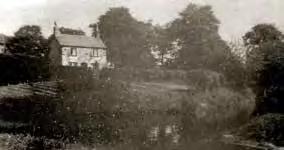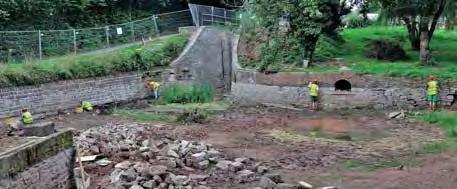
7 minute read
Restoration Hub
Digging Deeper
Waterways talks to Ralph Mills, leader of the WRG Canal Camps that uncovered a lost lock co age at Ty Coch
ALL PICTURES BY RALPH MILLS
There’s just one known photograph of the cottage at Shop Lock.
Everything on an archaeological site must be carefully recorded.

The restoration of the Ty Coch fl ight on the Monmouthshire & Brecon Canal in Wales is an ongoing project supported by IWA’s Waterway Recovery Group. Volunteers have been assisting with the reconstruction of the locks as part of the Waterworks programme, a Heritage Lo ery-funded partnership between Torfean Coun Borough Council and the Monmouthshire, Brecon & Abergavenny Canal Trust, since 2014 on WRG Canal Camps. But the discovery of a large amount of po ery agments near Shop Lock led to WRG undertaking an archaeological dig – the fi rst of its kind on the canal network – that spanned six weeks over three summers starting in 2017.
ARCHAEOLOGY ON THE CANALS
Heading up the team was Ralph Mills, an archaeologist with 30 years’ experience in the fi eld. He fi rst became involved with Canal Camps in 2008 while walking along the Grand Western Canal and reading a plaque about WRG’s involvement in the discovery of the remains of a boat-li . His interest was piqued and he joined the next available Canal Camp. With expert knowledge in the signifi cance of artefacts buried beneath the topsoil, Ralph has been at the fore ont of a handful of specialist WRG digs that have sought to investigate lost canalside structures. These have mainly been on the Stover Canal where the remains of a boat and granite tramway were excavated at Ventiford Basin, and on the Mon & Brec Canal at Ty Coch.
“The canals are a 2,500-mile long archaeological site,” explains Ralph. “But there hasn’t been much practical archaeology on them to date. There are a few recently opened waterways but most canals are at least 100, if not 200, years old. Work is mostly focussed on restoring navigation and maintaining locks or buildings but we should also be looking at them as sources of knowledge about the past, not just as places of leisure and pleasure for the present.”
The fi rst archaeological dig at Shop Lock took place in 2017. WRG volunteers have been helping to restore the Ty Coch fl ight on the Mon & Brec since 2014.
Shop Lock
When working on the Ty Coch fl ight in 2016, objects discovered just south of Shop Lock drew Ralph’s a ention: an unusually large number of po ery pieces, mostly featuring blue-and-white designs, and other domestic rubbish. “It seemed to me that there was more of this stu than there should have been. Ty Coch isn’t actually next door to anywhere; there’s a hamlet about 1km up the canal, there’s what used to be a cider mill about 0.5km in the other direction, but there’s nothing to explain why there should be this amount of material sca ered here.”
Beside the lock was once a workshop with a saw pit, uncovered by a previous excavation by the Ancient Cwmbran Socie in 2013. It was likely to have been used for building and maintaining lock gates (hence the name Shop Lock), and was located close to the foundations of a further building, marked on an 1890s Ordnance Survey map and thought to be a lock co age. Demolished in the late 1950s, nobody in the local area seemed to know anything about the co age but Ralph persuaded WRG that it was worth investigating.
Uncovering the cottage
The fi rst dig took place in 2017 over two week-long Canal Camps. Among the 100 or so volunteers involved





Expanding the trench revealed the cottage had two rooms.


Volunteer Anne-Marie Burdett uncovered the fi rst evidence of the cottage. The plan of the cottage.
in the project over the three seasons, only two had any relevant archaeology experience, so Ralph was tasked with training the enthusiastic group in the basic skills needed to scrape away layers of soil without damaging any potential fi nds. “Archaeology is quite a demanding discipline as you only get one chance at things,” explains Ralph. “If you were to dig something and destroy it before being able to record it, you can’t go back in time to dig it again more carefully. That’s why the training aspect of this is really important.”
In that year, Ralph’s intuition was proved to be spot on when volunteers exposed stones that formed the base of two walls, a doorway and two mortarcement fl oors. Expanding the size of the excavation site over the next two years revealed a building with at least two ground-fl oor rooms, one of which contained a fi replace and two brick structures (“Almost certainly for a copper boiler, meaning it would have been a scullery,” surmises Ralph), as well as an external passageway with a brick and fl agstone fl oor over a drainage system.
Ralph and his teams of volunteers spent the fi nal fortnight at Shop Lock meticulously plo ing out, measuring and photographing the co age’s remains. Working with MBACT, they made the site safe in the hope that it can be easily uncovered in the future should plans to make it into a visitor a raction come to uition. “Normally we would have refi lled the site but the local trust decided that they wanted it to be visible. That involved shi ing quite a lot of gravel, laying down a textile membrane and pu ing new gravel over the top,” explains Ralph. “We also had to consolidate the walls – they were made using a quite so lime mortar, so we had to strengthen them. We used a mortar that was radically di erent in colour, which means that if someone comes along in future years to remove or record what was done in 2019, it will be a reasonably easy process.”

The tiled fi replace was uncovered during the 2018 dig.
Mystery rubbish
The collection of agments that fi rst indicated Shop Lock was worth investigating, however, was located a short distance om the co age, below the lock pound. “One of the fascinating things about the area is that it is crammed full of rubbish – a slightly odd mixture of 19th- and early 20th-century domestic and industrial objects,” Ralph comments. “We had material working backwards om the very recent past (a baby’s shoe and dummy, for example), to an abundance of transferprinted po ery featuring huge variations in designs. Dozens of bits of clay pipe – local ones om Cardi , others om Ireland – were found too and these are good for dating fi nds.”
A few discoveries on the site hint at what might have gone on there. One example Ralph gives is remnants of a bicycle and its bell. “The lock-keeper here had a fl ight to look a er, so it may have been his bicycle that he pedalled up and down the towpath. As archaeologists, there are li le stories like this that we can propose as possibilities om the evidence that we fi nd.”
However, the reason for the large amount of material below the lock remains a mystery. “It’s miles om anywhere and I don’t think the lock-keepers would have gone that far om the co age, over the canal and round the pound, to dump their rubbish,” says Ralph. “The working boaters didn’t live on their cra on the Mon & Brec, so it’s unlikely to be their rubbish that’s been dredged om the bo om of the canal.”
“The puzzle is that we found stu very similar to what we did on the Canal Camp I led on the Stover Canal about fi ve years ago,” he continues. “A year or two before that I helped on a Canal Camp on the Swansea Canal and, lo and behold, we found the same sort of material there too. So there seems to be a relationship between canals or canalsides and collections of 19th-century rubbish, but I can’t answer what that connection is yet.”
Painstakingly recorded, photographed and boxed up by Ralph, the fi nds om the Shop Lock site will be stored by the organisers of the Waterworks project with the long-term aim of them being incorporated into a visitor a raction. In the meantime, high-resolution photographs of the items will be available to view online (fi resofprometheus.org). “Hopefully someone who’s as enthusiastic as me about transfer-printed po ery will be able to use those images in their own research on 19th-century sites, especially those related to canals,” says Ralph.
While his expertise enabled the Shop Lock project to be undertaken, Ralph credits much of its success to the hard work of the volunteers, who ranged in age om teenagers to septuagenarians, and included representatives om WRG’s European partner, REMPART.






